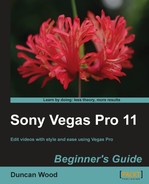Before we import our media into our newly-created project, I want to bring your attention to the Preview monitor. This preview screen is where you will be seeing the output of your editing and the effects you apply to your media clips. Ideally, you will have a second screen attached to your editing computer where you can either move the Preview monitor onto or where you can use the Video Preview on External Monitor function. If you are using one screen, then you will need to resize the Preview Monitor where you are able to clearly see your edits, but at the same time, leave enough acreage on your screen to be able to work with your media on the timeline.

In the previous image, you can see at the top of the Preview monitor a series of buttons. The x, <, and row of dots at the top-left are for closing the Preview monitor, sliding the monitor out of the way of other windows, and for grabbing and holding the monitor window to detach and move it around your desktop, respectively.
The next square with the mouse icon in it is another way to open the Project Properties window. The little Blue Monitor is to send the preview video to an external monitor. If you select from the menu Options | Preferences and select the Preview Device tab, you can choose which device you wish to use as your external monitor. For a second computer screen, you would select Windows Secondary Display from the device drop-down window. Once this is set up, by clicking the little Blue Monitor your preview will also appear on the second screen for a larger preview as well as the Monitor Preview window.
To the right of the Blue Monitor button is the Sony standard symbol for FX plugins. Here you can insert Video FX over the Preview Monitor such as a color correction plugin to help calibrate the colors of your monitor.
The Split Screen view button is a great way to compare what an effect is doing to your video. One half will be affected while the other half remains unaffected for your comparison.
The Preview Quality drop-down is an important menu to get to know. Within this there are four main settings: Draft, Preview, Good, and Best with subheadings under each including Auto, Full, Half, and Quarter. Depending on the CPU and video card power available on your system, certain combinations of these settings work the best. The system defaults to Preview (Auto), which should give very adequate monitoring, but as you add FX plugins to your project and more edits and cuts to the timeline, the system starts to become taxed and will need to drop the Monitor preview quality. We will leave it as the default setting for now.
The Overlays button is essential when creating video for TV, particularly the Safe Areas grid setting. By keeping your main content between the safe area lines and the center of the screen, the zoom in effect (or over scan) of some TVs won't cut off some of your important text or on-screen action.
Finally, the last two buttons allow you to grab still images from the preview screen. The first saves the image to the clipboard allowing you to paste it into your photo editing software, and the second saves the image to your location of choice on your hard drive for recall later. You can select between JPG and PNG formats to save your images. Obviously set your Preview Quality to Best Full for the highest quality image before taking the snapshot.
Importing media clips into the project is a fairly easy function to use. Here we will bring the video and audio clips needed for our Project into the timeline. As we have already established the Project Properties previously, all we need to do now is to select the explorer window just above the Track Header and use the usual windows explorer functions to find our downloaded files. You should find Take 1, Take 2, Take 3, and Master Audio.
